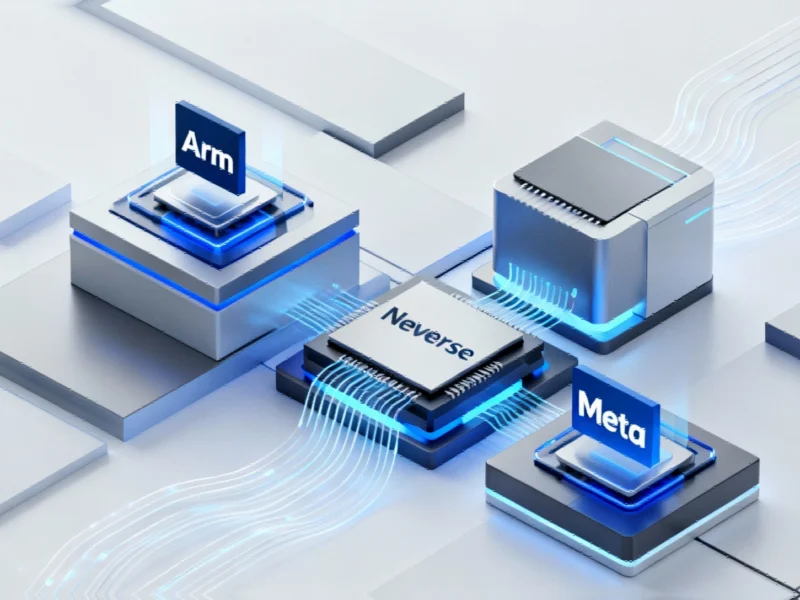Tech Giants Unite for Next-Generation AI Computing
In a landmark collaboration that could reshape the artificial intelligence landscape, Meta has entered into a multi-year partnership with semiconductor architecture leader Arm to dramatically enhance the efficiency and scalability of its AI systems. This strategic alliance, detailed in the comprehensive coverage from Industrial News Today, represents a significant shift in how major technology companies are approaching the computational demands of advanced AI applications.
The partnership centers on Meta’s adoption of Arm’s Neoverse computing platform to power critical AI operations, including the social media giant’s sophisticated search ranking algorithms and recommendation engines that serve billions of users worldwide. This move away from traditional x86 architectures signals a broader industry transition toward specialized, power-efficient computing solutions for AI workloads.
The Performance-Per-Watt Revolution
Arm’s leadership has emphasized that the Neoverse platform enables Meta to achieve what the companies describe as “performance-per-watt parity” – a crucial metric in an era where AI data centers are facing increasing scrutiny over energy consumption and environmental impact. According to technical assessments, Arm-based systems demonstrate superior energy efficiency compared to conventional x86 architectures while maintaining competitive computational performance.
This efficiency breakthrough comes at a critical time for the AI industry, as highlighted by recent policy discussions about technological trade-offs in computing infrastructure. The partnership addresses growing concerns about the sustainability of scaling AI systems while managing operational costs and environmental footprints.
Deep Software Integration and Optimization
Beyond hardware implementation, the collaboration involves extensive optimization of Meta’s foundational AI software stack. Engineering teams from both companies have worked to enhance critical components including Facebook’s General Matrix Multiplication (FBGEMM) library and PyTorch’s ExecuTorch Edge-inference runtime engine. These optimizations have yielded measurable improvements in inference efficiency and throughput – key performance indicators for production AI systems.
The software enhancements developed through this partnership have been contributed to the open source community, enabling broader adoption and collective improvement. This approach mirrors similar industry movements toward open innovation in AI infrastructure, where major players are recognizing the strategic value of collaborative development.
Strategic Implications for AI Infrastructure
Santosh Janardhan, Meta’s head of infrastructure, emphasized the transformative potential of the partnership: “From the experiences on our platforms to the devices we build, AI is transforming how people connect and create. Partnering with Arm enables us to efficiently scale that innovation to the more than three billion people who use Meta’s apps and technologies.”
Arm CEO Rene Haas framed the collaboration within the broader context of AI evolution: “AI’s next era will be defined by delivering efficiency at scale. Partnering with Meta, we’re uniting Arm’s performance-per-watt leadership with Meta’s AI innovation to bring smarter, more efficient intelligence everywhere – from milliwatts to megawatts.”
Neoverse Platform Evolution and Market Position
Arm’s Neoverse platform, first introduced in 2018, has evolved into a comprehensive computing architecture divided into three specialized series: the V-series for high-performance general-purpose computing, the N-series targeting server markets, and the E-series optimized for edge computing applications. The platform’s modular design enables customization for specific workload requirements, making it particularly suitable for diverse AI applications.
The 2023 introduction of Neoverse CSS (Compute Subsystems) further accelerated adoption by simplifying integration and reducing development timelines for partners seeking to implement Arm-based solutions. This advancement aligns with broader industry initiatives focused on sustainable technological progress through improved manufacturing and design methodologies.
Broader Industry Context and Competitive Landscape
This partnership emerges amid intense competition in the AI hardware space, where companies are racing to develop more efficient computing solutions. The collaboration represents a significant validation of Arm’s architecture for demanding AI workloads and could influence other technology giants considering similar transitions.
The timing coincides with increased focus on harnessing real-world data for AI training and the computational challenges associated with processing massive datasets. Meta’s commitment to Arm-based solutions suggests confidence in the architecture’s ability to handle the scaling demands of future AI applications.
Future Outlook and Industry Impact
The Meta-Arm partnership signals a potential industry shift toward heterogeneous computing architectures optimized for specific AI workloads. As companies confront the practical limitations of current AI infrastructure, collaborations like this one could establish new benchmarks for performance, efficiency, and scalability.
This development also reflects the kind of strategic repositioning seen in other sectors, similar to major corporate restructuring initiatives where companies are focusing resources on core competitive advantages. For Meta, the partnership represents a strategic investment in infrastructure that could define its AI capabilities for years to come.
The collaboration between Meta and Arm represents more than just a technology partnership – it’s a strategic alignment that could influence the fundamental architecture of future AI systems worldwide. As the industry grapples with the dual challenges of scaling AI capabilities while managing resource consumption, this alliance offers a compelling blueprint for sustainable AI advancement.
Based on reporting by {‘uri’: ‘datacenterdynamics.com’, ‘dataType’: ‘news’, ‘title’: ‘DCD’, ‘description’: ‘The ultimate source for data center news, analysis and opinion at https://t.co/LZ1IWZbvVu’, ‘location’: {‘type’: ‘place’, ‘geoNamesId’: ‘2643743’, ‘label’: {‘eng’: ‘London’}, ‘population’: 7556900, ‘lat’: 51.50853, ‘long’: -0.12574, ‘country’: {‘type’: ‘country’, ‘geoNamesId’: ‘2635167’, ‘label’: {‘eng’: ‘United Kingdom’}, ‘population’: 62348447, ‘lat’: 54.75844, ‘long’: -2.69531, ‘area’: 244820, ‘continent’: ‘Europe’}}, ‘locationValidated’: False, ‘ranking’: {‘importanceRank’: 344832, ‘alexaGlobalRank’: 62406, ‘alexaCountryRank’: 34716}}. This article aggregates information from publicly available sources. All trademarks and copyrights belong to their respective owners.



